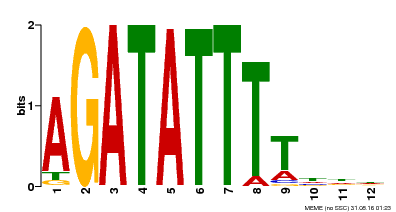| Signature Domain? help Back to Top |
 |
| No. |
Domain |
Score |
E-value |
Start |
End |
HMM Start |
HMM End |
| 1 | Myb_DNA-binding | 44.7 | 3.2e-14 | 43 | 87 | 1 | 47 |
TSSS-HHHHHHHHHHHHHTTTT-HHHHHHHHTTTS-HHHHHHHHHHH CS
Myb_DNA-binding 1 rgrWTteEdellvdavkqlGggtWktIartmgkgRtlkqcksrwqky 47
r +WT+eE++++++a +++ + Wk+I +g +t q++s+ qky
AT3G09600.1 43 RESWTEEEHDKFLEALQLFDRD-WKKIEDFVG-SKTVIQIRSHAQKY 87
789*****************77.*********.*************9 PP
|
| Publications
? help Back to Top |
- Riechmann JL, et al.
Arabidopsis transcription factors: genome-wide comparative analysis among eukaryotes.
Science, 2000. 290(5499): p. 2105-10
[PMID:11118137] - Dal Bosco C, et al.
Inactivation of the chloroplast ATP synthase gamma subunit results in high non-photochemical fluorescence quenching and altered nuclear gene expression in Arabidopsis thaliana.
J. Biol. Chem., 2004. 279(2): p. 1060-9
[PMID:14576160] - Yamada K, et al.
Empirical analysis of transcriptional activity in the Arabidopsis genome.
Science, 2003. 302(5646): p. 842-6
[PMID:14593172] - Rizhsky L,Davletova S,Liang H,Mittler R
The zinc finger protein Zat12 is required for cytosolic ascorbate peroxidase 1 expression during oxidative stress in Arabidopsis.
J. Biol. Chem., 2004. 279(12): p. 11736-43
[PMID:14722088] - S
ABA activates ADPR cyclase and cADPR induces a subset of ABA-responsive genes in Arabidopsis.
Plant J., 2004. 38(3): p. 381-95
[PMID:15086800] - Yanhui C, et al.
The MYB transcription factor superfamily of Arabidopsis: expression analysis and phylogenetic comparison with the rice MYB family.
Plant Mol. Biol., 2006. 60(1): p. 107-24
[PMID:16463103] - Gutierrez L, et al.
Identification of new gene expression regulators specifically expressed during plant seed maturation.
J. Exp. Bot., 2006. 57(9): p. 1919-32
[PMID:16606634] - Manfield IW, et al.
Arabidopsis Co-expression Tool (ACT): web server tools for microarray-based gene expression analysis.
Nucleic Acids Res., 2006. 34(Web Server issue): p. W504-9
[PMID:16845059] - Lee DJ, et al.
Genome-wide expression profiling of ARABIDOPSIS RESPONSE REGULATOR 7(ARR7) overexpression in cytokinin response.
Mol. Genet. Genomics, 2007. 277(2): p. 115-37
[PMID:17061125] - Ascencio-Ib
Global analysis of Arabidopsis gene expression uncovers a complex array of changes impacting pathogen response and cell cycle during geminivirus infection.
Plant Physiol., 2008. 148(1): p. 436-54
[PMID:18650403] - Agudelo-Romero P, et al.
Changes in the gene expression profile of Arabidopsis thaliana after infection with Tobacco etch virus.
Virol. J., 2008. 5: p. 92
[PMID:18684336] - Rawat R, et al.
REVEILLE1, a Myb-like transcription factor, integrates the circadian clock and auxin pathways.
Proc. Natl. Acad. Sci. U.S.A., 2009. 106(39): p. 16883-8
[PMID:19805390] - Farinas B,Mas P
Functional implication of the MYB transcription factor RVE8/LCL5 in the circadian control of histone acetylation.
Plant J., 2011. 66(2): p. 318-29
[PMID:21205033] - Farinas B,Mas P
Histone acetylation and the circadian clock: a role for the MYB transcription factor RVE8/LCL5.
Plant Signal Behav, 2011. 6(4): p. 541-3
[PMID:21474993] - Rawat R, et al.
REVEILLE8 and PSEUDO-REPONSE REGULATOR5 form a negative feedback loop within the Arabidopsis circadian clock.
PLoS Genet., 2011. 7(3): p. e1001350
[PMID:21483796] - James AB,Syed NH,Brown JW,Nimmo HG
Thermoplasticity in the plant circadian clock: how plants tell the time-perature.
Plant Signal Behav, 2012. 7(10): p. 1219-23
[PMID:22902701] - Hsu PY,Harmer SL
Circadian phase has profound effects on differential expression analysis.
PLoS ONE, 2012. 7(11): p. e49853
[PMID:23185460] - Hsu PY,Devisetty UK,Harmer SL
Accurate timekeeping is controlled by a cycling activator in Arabidopsis.
Elife, 2013. 2: p. e00473
[PMID:23638299] - Ding Y, et al.
Four distinct types of dehydration stress memory genes in Arabidopsis thaliana.
BMC Plant Biol., 2013. 13: p. 229
[PMID:24377444] - Xie Q, et al.
LNK1 and LNK2 are transcriptional coactivators in the Arabidopsis circadian oscillator.
Plant Cell, 2014. 26(7): p. 2843-57
[PMID:25012192] - Fogelmark K,Troein C
Rethinking transcriptional activation in the Arabidopsis circadian clock.
PLoS Comput. Biol., 2014. 10(7): p. e1003705
[PMID:25033214] - P
Time-dependent sequestration of RVE8 by LNK proteins shapes the diurnal oscillation of anthocyanin biosynthesis.
Proc. Natl. Acad. Sci. U.S.A., 2015. 112(16): p. 5249-53
[PMID:25848001] - Xing H, et al.
LNK1 and LNK2 recruitment to the evening element require morning expressed circadian related MYB-like transcription factors.
Plant Signal Behav, 2015. 10(3): p. e1010888
[PMID:25848708] - Gray JA,Shalit-Kaneh A,Chu DN,Hsu PY,Harmer SL
The REVEILLE Clock Genes Inhibit Growth of Juvenile and Adult Plants by Control of Cell Size.
Plant Physiol., 2017. 173(4): p. 2308-2322
[PMID:28254761]
|





